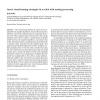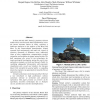66 search results - page 11 / 14 » Autonomous visual navigation of a mobile robot using a human... |
AAAI
2007
13 years 9 months ago
2007
Often remote investigations use autonomous agents to observe an environment on behalf of absent scientists. Predictive exploration improves these systems’ efficiency with onboa...
BC
2000
13 years 7 months ago
2000
Abstract The visual homing abilities of insects can be explained by the snapshot hypothesis. It asserts that an animal is guided to a previously visited location by comparing the c...
ICRA
2002
IEEE
14 years 12 days ago
2002
IEEE
—The simultaneous localization and map building (SLAM) problem asks if it is possible for an autonomous vehicle to start in an unknown location in an unknown environment and then...
TROB
2002
13 years 7 months ago
2002
Abstract-We describe Localization-Space Trails (LOST), a method that enables a team of robots to navigate between places of interest in an initially unknown environment using a tra...
ICRA
1998
IEEE
13 years 11 months ago
1998
IEEE
In June and July 1997, Nomad, a planetary-relevant mobile robot, traversed more than 220 kilometers across the barren Atacama Desert in Chile, exploring a landscape analogous to t...


